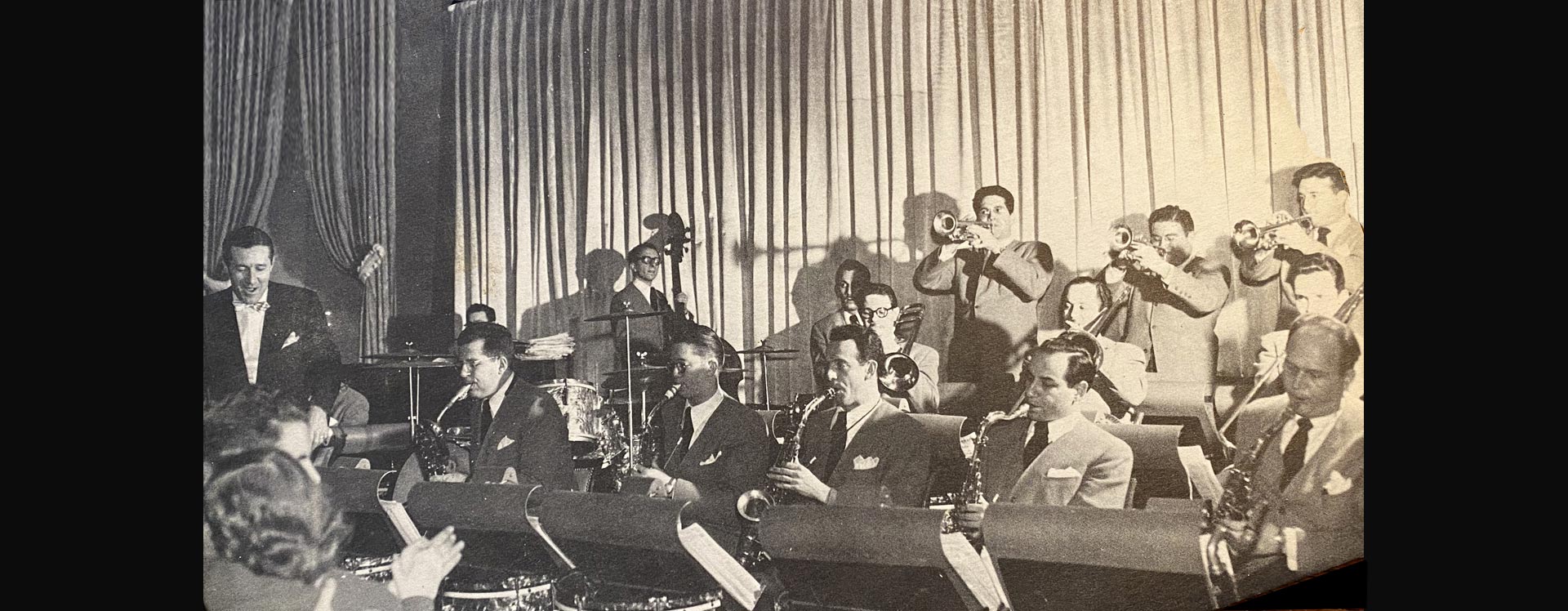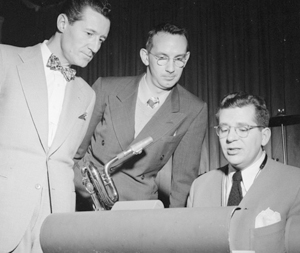

Photo above: Ray McKinley Orchestra.
Below: Ray McKinley, Eddie Sauter, and (Robert) Dean Kincaide, Hotel Commodore, 1947.
In 1938, drummer Ray McKinley, a Fort Worth, TX native, caught the end of a set by Red Norvo's group in Cincinnati, Ohio while touring with Jimmy Dorsey's band. He was introduced to a trumpet player from Norvo's ensemble that had also apparently done some arranging for the band. Though the two did not know it at the time, their business relationship would afford the young arranger the opportunity to record the music he really wanted to record in his lifetime.
The arranger, of course, was Eddie Sauter. McKinley had just come back from leading Glenn Miller's Army Air Force band during the war for a year beginning in December 1944. He decided to put his own band together under his own name.
McKinley noted that "...when he [booking agent Willard Alexander] suggested that Eddie become our arranger when we immediately started that good band of '46 (late '45 and '46) Eddie was the only arranger, except for one or two..." Eddie Sauter was given carte blanche to write originals as he saw fit.
Since Eddie Sauter got in with the McKinley band basically from Day 1, the thirty-two-year-old innovator penned a large percentage of the early McKinley Orchestra library.
Ray McKinley recounted the extent to which Sauter was offered the liberty to compose and arrange as he saw fit. "He could do anything he wanted to. It was what he wanted to do that made the decisions. Although, I would come up occasionally with some crazy idea."11 Perhaps owing to his history writing for the likes of Goodman, Shaw, and Herman, Sauter still found a way to include popular songs into his scope.
Sauter's original "Sand Storm" appeared alongside arrangements of standards like "The Carioca" and "We'll Gather Lilacs" with vocalist Evelyn Stallings in February 1946. "Sand Storm" contains the standard Sauter brilliance..." including a rather harmonically complex and frequently modulating development section.
"Tumblebug," Sauter's original for McKinley, possesses elements of contemporary classical music of the '40s that few other swing band leaders would have permitted. McKinley's openness drove Sauter to expand his horizons through compositional experimentation. According to one of Willard Alexander's public relations men, Irv Dinkin, there was a clause in the contract Sauter had with McKinley which stipulated that Sauter's writing was not to be altered without Eddie's consent.
Following two solid years of writing for the McKinley band, Sauter found himself at the mercy of recurring bouts of tuberculosis, and in 1948 his time with McKinley drew to a close. While recovering from yet another bout, Sauter received a letter with an offer that would shape his musical future for most of the next decade.

Recommended: Listen on headphones or external speakers.
Ray McKinley & His Orchestra
"Sand Storm"
1946
See Music Analysis for "Sand Storm"
"Tumblebug"
1946
THE 1946 BAND: Ray McKinley (director, vocals, lead drummer); Rusty Dedrick, Chuck Genduso, Jack Steele (trumpets); Jim Harwood, Charlie Castaldo (trombone); Peanuts Hucko (clarinet, alto sax); Walt Milford, Harry Wuest (alto sax); Chuck Grant (tenor sax); Larry Molinelli (baritone sax); Whitey Woods (piano); Mundell Lowe (guitar); Rollo Laylan (drums); Evelyn Stallings, Teddy Norman (vocals); Eddie Sauter (arranger).
"'Sand Storm' contains the standard Sauter brilliance..." — Alex Chilowitz